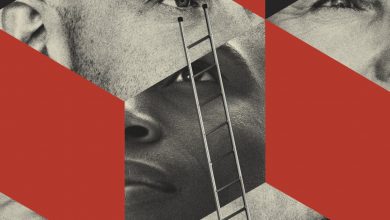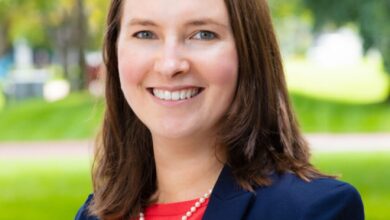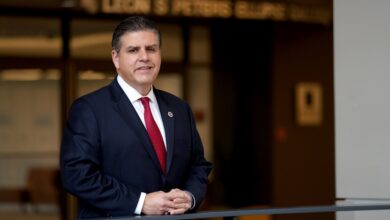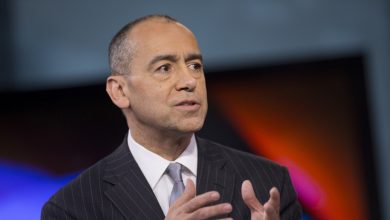The Semester of Magical Thinking
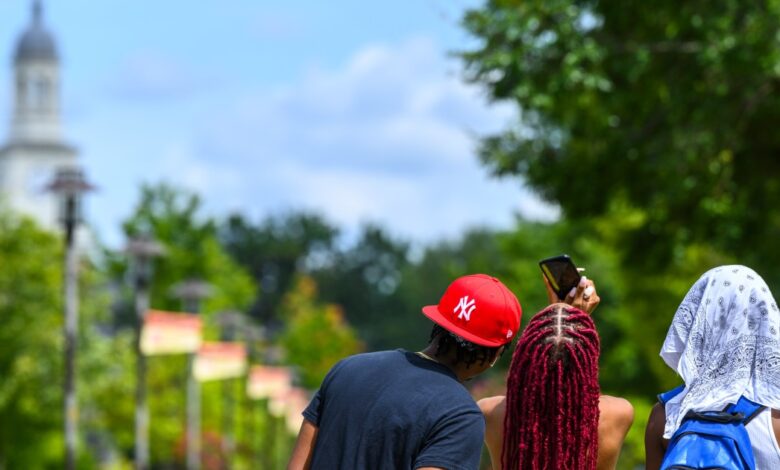
[ad_1]
It was the second day of her junior year and Hussain, 20, saw far fewer students walking around than she’d expected. Still, she was relieved to be there. For a year and a half, she had logged on to her classes remotely from an apartment in the Bronx where she lives with her parents, grandmother, and three siblings. Her younger siblings attended middle and high school fully online and her older sister worked remotely as an accountant. Whenever her sister had a meeting, everyone had to stay quiet. Once the internet went out for almost two weeks.
“Learning online,” she said, “I was very easily distracted. Yeah, I’d have a class on, but I’m in the kitchen cooking or doing other chores around the house that have to be done.” School was not the priority.
Hussain served on the student government last year. She applied for and got into an honors program at City College. But she also worked two part-time jobs. She was so busy, and it was so hard to stay motivated. She had little time to make friends. Last spring she dropped student government.

Mansura Khanam for The Chronicle
“I’m excited about being back on campus,” she said. “I feel like I’ll be more engaged in student activities.”
A year and a half ago as the city became one of the nation’s first Covid-19 hot spots, it was a relief when the City University of New York’s colleges, including City College, moved online. The months that followed were devastating. The coronavirus spread rapidly in New York and many of the people who suffered were those who lived in crowded apartments and worked jobs that could not go remote — like much of City College’s population. CUNY lost at least 56 people to Covid-19, according to a memorial page that the university set up to honor them, six of whom were at City College. They were students, professors, administrators, and more.
Distraction, sickness, lives lost. Students, professors, and campus leaders hoped that by this fall, those would be artifacts of a painful year. Earlier this summer, a return to some version of normalcy seemed within reach. But the first week back, it was clear that “normal” was still a long way off.
The same was true at colleges across the country, but the degree to which people acknowledged that reality varied widely. The Delta variant had driven up the number of hospitalizations nationwide to levels not seen since early February, before vaccines were widely available. Young people were now a greater share of the dying. Operating in person without the strictest safety protocols — vaccination mandates, indoor-mask requirements, social distancing — risked lives on campus and in the community. But many campus leaders, some of them limited by finances or state politics, pushed ahead with reopening plans. Zero risk is impossible, and leaders assured protesting faculty members that they were taking reasonable precautions.
Excitement like Sadiya Hussain’s was the prevailing feeling among students, though, and even among many faculty members, on four very different campuses The Chronicle visited last week. After so much waiting, they were eager to return. They couldn’t, or wouldn’t, think too hard about the less pleasant facts.
After about an hour of speeches and a picket line, Stemberg, an adjunct assistant professor and acting chair of the union’s City College chapter, headed uptown to her office on campus. She said conditions were better there, compared with other CUNY colleges. She was on a committee of union members who toured campus buildings to determine whether they were safe for in-person work, so she knew firsthand that the college has HVAC systems that comply with CDC guidelines, she said. The percentage of classes that will be held fully in person is under 5 percent at City College, with most scheduled to be online or hybrid of the two.

Dave Sanders
But Stemberg worried about what this fall would bring. One of the earliest confirmed cases in New York involved a student in one of her classes. Many other students got the disease and some lost family members. She felt that CUNY administrators were pushing too much in-person work on a system that wasn’t ready for it.
“We’re almost there,” she said. “We’re not there yet.”
In an email, a CUNY spokesman said the university has “conducted a rigorous inspection of ventilation systems and other essential safety features in the classrooms, offices, laboratories, libraries and other spaces that will be in use.” Each CUNY campus’s reopening plan was written “in accordance with city, state, and federal guidance,” he said. There is a vaccine mandate, but students have until late September to show they’ve complied. In early July, 59 percent of students were vaccinated systemwide, a number that has likely risen. Vincent Boudreau, the City College president, said he wants more people to come back to campus, but the only way to protect people is with the vaccine.
On Thursday afternoon, there was a line out the door of one of the main classroom buildings; a security guard was checking for either vaccine cards, a negative Covid test, or a sticker that students and employees can put on their IDs that shows they’re vaccinated. The guard turned some people away. A Covid-19 testing site at the edge of campus had five or six people in line.

Mansura Khanam for The Chronicle
Celia P. Lloyd, vice president for student affairs and enrollment management, walked around campus to get a sense for how it was all going. Near the entrance of the classroom building, another staff member stopped her to tell her they had run out of the stickers for people’s IDs.
“Ouch,” she said. What were they telling students? Come back tomorrow.
Lloyd’s phone constantly lit up with a steady stream of messages from her colleagues. “This is my life now,” she said. Throughout the day, she was in logistics meetings, trying to figure out how to get an unusually large number of freshmen into classes, why some students hadn’t gotten certain emails, where students would go to log on to Zoom when they’re on campus but need to take an online class.
“We’re building a bridge while we’re crossing it,” she said.
She walked into the cafeteria and her spirits lifted. Students were there, working on laptops and eating lunch. It looked like college.
Other parts of the campus were almost completely empty. “It’s really sad,” said Ellen Handy, an associate professor of art history who was one of only a handful of people inside the large classroom building that’s home to her office. “Our campus is a place where people come together from all across the city, across the world,” she said. “The work we do is often about being in the same room.”
When the college switched to remote learning last year, Handy said almost a third of her students stopped coming to class. Some she never heard from again.
“To lose that many students from a classroom and have no way of finding them or reaching them was unbearable,” she said.

Mansura Khanam for The Chronicle
She understood why the campus was sparsely populated now. Many of her students commute well over an hour from Queens and the Bronx by bus and subway. Years of underfunding meant the college did not have the money to make all the safety improvements they might like. If all students returned, there might not be enough room in some buildings to socially distance properly. The elevators were small and slow. People were concerned about ventilation. With the Delta variant raging, it might not be safe to go back.
Some staff wonder why this many people are back at all. According to City College’s reopening plan, students would return to campus if New York City’s average Covid-positive test rate was below 3 percent. On Saturday the percentage of New Yorkers testing positive for Covid-19 was at 3.55 percent. “It makes it very difficult to plan,” said Carlos Parker, assistant director of admissions. Ken Ihrer, vice president of operations, said that the college was “not authorized by CUNY to open fully remote and therefore it could not be considered.” He added that most 45 percent of the courses are hybrid, and most of those are meeting only when students take tests.
Blaine and Burgundy Hill, a married couple who work as a network administrator and adjunct professor, respectively, picked up burgers and chips inside, then removed their masks once they were outdoors. It was hot under the tent and soon it became very loud, too: Quincy’s president acted as game-show host for a prize raffle. The women’s basketball and softball coaches arrived, prompting uproarious cheers from their teams because the coaches recently got engaged to each other.
“It’s nice to have students back on campus,” Blaine said, “to be able to have events like this again.”
During the 2020-21 academic year, Quincy had sharply curtailed some of its in-person activity. Students underwent surveillance testing and quarantines. They weren’t supposed to visit friends in other dorms. Cafeteria meals were all grab-and-go. At the same time, students continued to live on campus and sports teams practiced and played on modified schedules.

Ted Schurter for The Chronicle
Half of Quincy’s undergraduates are the first in their families to attend college and about a third receive Pell grants. “It was not clear to us that they would be safer or have had better medical care if they were away from campus than if they were on campus,” said Brian McGee, the president. “We certainly knew many of them would struggle with internet connectivity and other resources.”
By the time students left for Thanksgiving, 22 percent of them — 249 — had tested positive for the coronavirus.
That fall, Quincy University posted one of the 10 highest rates of reported college infections in the entire country, as tracked by The New York Times. (Many more colleges may have had similar rates but the vast majority didn’t thoroughly test their communities, and so probably missed infections.) After a calmer spring semester, with eight reported student infections, Quincy ended its academic year among the 30 colleges with the highest-reported rates in the nation, out of more than 1,800 colleges that the Times tracks and for which there are federal enrollment data.
Fifteen full-time employees tested positive over 2020-21. Among all campus community members, Quincy University has seen one hospitalization related to Covid-19, and no deaths.
With the Delta variant surging and a lack of vaccine mandates at many campuses, higher-ed employees across the country are demanding more remote-work options. They fear they’ll get infected by students and bring the virus home to vulnerable family members or children who aren’t yet eligible to get vaccines. Yet, despite last year’s numbers, Quincy staff and faculty seem more at ease. Most of those The Chronicle spoke with over a weekend of visiting the campus, and in phone calls before and after, said they felt good about working and teaching in person.
They trusted Quincy’s Covid protocols. As the semester opened, the university was requiring masks of everyone in classrooms and surveillance-testing athletes, who make up more than half of undergraduates. It wasn’t requiring Covid vaccines. Quincy is a Catholic college, founded in 1860 by German Franciscan friars, and its leaders today interpreted guidance from the Vatican as banning such mandates.
However, before the first week of class was over, Illinois’s governor issued an executive order imposing a vaccine mandate, plus stricter masking and testing rules, on all higher-education institutions in the state. McGee said the university would comply.
Days before the executive order, the university reported that 70 percent of students had at least started their Covid vaccination series. Eighty-nine percent of full-time employees had done the same. No one yet had tested positive.
“I feel like they have done a really good job of keeping safety in mind,” said Burgundy Hill, who’s also assistant director of the public library. Last year she stopped teaching a class at the local community college because she was worried about getting infected. This year, which will be her first at Quincy University, felt different: “Knowing the vaccination rate among faculty and students and with all the precautions in place, it feels as safe as it could be.”
“Especially teaching a class like public speaking, I don’t feel like students get the same experience doing that as an online class. It’s just not the same at all,” she said. “So I think it’s really important to be in person as much as you safely can.”
Michael J. McCabe and his wife, Carol, joined the Hills under the tent. McCabe is director of information-technology services and Blaine Hill’s boss. “I have high hopes — ” he said, before being interrupted by screaming from the basketball and softball players one table over. “I have high hopes for the year,” he continued. “I’m excited.”

Ted Schurter for The Chronicle
When asked about the college’s 2020-21 infection rates, employees, including McCabe and the Hills, knew the numbers. McGee had sent them out diligently. But most hadn’t thought about where the college now stood in comparison with others across the country. They saw that it was taking Covid-19 much more seriously than the surrounding community and region.
In the town of Quincy, stores were open for business, masks were practically nonexistent, and a vocal group of parents had paid for a vinyl sign, hung on a semi-truck trailer parked by a main road, that urged local school boards to “UNMASK OUR CHILDREN.” As of Friday, transmission rates in Adams County were high, and 44 percent of residents were vaccinated against Covid-19.
With a population of 40,000, Quincy is the largest city within almost 100 miles in any direction. Colleges with stricter Covid rules and lower infection rates can seem far away.
In interviews, many employees were quick to defend the university. Told that the university’s infection rate was one of the highest in the country, Carla Passini, the women’s softball coach, said she nevertheless thought the rate was “kind of good.”
She was looking forward to playing a full season. “I don’t have any alarm,” she said. “I’m thrilled that we’re back.”
Kenneth Oliver, dean of the school of education, spoke with The Chronicle in the early evening on Monday, just before his first in-person course of the fall. Students were scarce outdoors, and the campus was quiet. Oliver said he felt comfortable teaching because he had small classes with graduate students, but he worried about members of his department who teach larger numbers of undergraduates.

Ted Schurter for The Chronicle
“I’m a mental-health counselor by trade, so without question, my preference would have always been to make sure that we’re taking care of people’s health first and considering health over even sustainability,” he said. The sun lowered and the wind picked up, providing brief relief from the day’s heat. “I won’t call it profit,” he said. “I’ll just say sustainability.”
It was no idle statement. Quincy University has long struggled with finances. In tax filings, it hasn’t reported net income since 2013. Things haven’t gone as badly during the pandemic as they might have, however. In its latest available audit, covering May 2019-May 2020, auditors rated the college as financially healthy. Enrollment rose this fall, compared with the past two years. Why? The vice president for enrollment management, Tom Oliver (no relation to Kenneth), attributed the uptick to the university’s continuing to hold in-person tours.
Nora Baldner, a former journalist and now assistant professor, also seemed ready to sacrifice even the college’s existence for fewer infections. “If the school closes, no one dies,” she said. “If Covid runs rampant, people die.”
“There’s something bigger than QU at stake that I’m not hearing in any discussions,” she said.
Healthy college-age adults generally do well with coronavirus infections, often feeling mild or no symptoms. What if one student had an unlucky experience, though? Baldner wondered. What about possible long-term consequences of infections that science doesn’t yet understand? The more students became infected, the more likely it was that the rare, more serious outcomes would strike.
As for Baldner’s own safety: “It’s like a pendulum,” she said. “I can get nervous and then I can get calm.”
At lunchtime on Monday, the first day of class, the tan QU tent was still up, but all the furniture was packed away. It was 90 degrees and oppressive, and no one lingered outdoors. Instead, they all ate inside, where the air conditioning hummed and things looked much as they had before the pandemic — the way they looked in town, where residents had been “back to normal” for months.

Matt Roth for The Chronicle
Morgan State’s careful planning helped make that lightness of heart possible. The historically Black university in Baltimore opted to wait until this fall to resume full on-campus operations. In April, months before the U.S. Food and Drug Administration issued full approval of a Covid vaccine, the university announced a vaccine mandate. When the Delta variant began to drive up infection rates, the college reinstated an indoor masking requirement. Students may not live in college housing without proof of vaccination unless they qualify for a religious or medical exemption, and before the first week of classes, administrators barred more than 100 students from moving in.
All remaining students, faculty, and staff have until September 17 to submit their proof of vaccination or risk “progressive disciplinary actions,” said David Wilson, the university president, in a letter addressed to the Morgan State community.
“The most important message that we can convey is simply, vaccines work,” Wilson said in the letter. “The risk to the vaccinated is small — whether to be infected or to infect others.”
Last semester, roughly 300 students whose circumstances made it safer and easier to stay on campus remained behind, along with some athletes. With this group, administrators formulated testing protocols and created a system to implement in the event of the campus reopening.
Morgan State developed a tight-knit response team led by the health center to respond to both the physical and emotional needs of students who contract Covid, according to Anita Hawkins, associate dean of the School of Community Health and Policy.
“The culture of an institution that is committed to a more personalized experience for students — that, I do believe, filtered down into our response,” Hawkins said.
That’s not to say no one is worried about infections. Although about 95 percent of students living on campus are vaccinated, the university had five positive Covid cases out of 527 tests in its first week, according to its Covid dashboard. As a result, the university has expanded its testing protocol to include vaccinated individuals on a stratified, random sampling basis, according to the president’s email to the campus community. Morgan is also seeing record enrollment numbers, and administrators are concerned about commuter students, who make up a significant share of the student population and whose vaccination statuses the university is still collecting.

Matt Roth for The Chronicle
With Morgan State’s safety protocols the risk of infection is lower than at many other colleges, though, and students and professors who talked to The Chronicle expressed excitement to be back on campus.
The last time Kye Toussaint took in-person classes, he was a freshman; now he is entering his junior year. He said the dorm where he worked as a resident assistant resembled a ghost town during the online-learning era.
Toussaint missed the events, the crowded dining halls, and interacting with other students. “You might see like one or two people that whole day and that’s it,” he said. When the computer-science major’s GPA fell to 3.2 from a 4.0, he cried.
“When it came to online class I was not paying attention. It was really hard to,” Toussaint said. “I do want to go back to class.”
In one classroom on Wednesday afternoon, students trickled in and sat at open computer stations, waiting for the professor, Susan Hendee, to begin the lecture. Everything seemed normal, except the course in information-science systems was at half capacity and everyone in the room wore face masks. The class was one of 800 the college calls “MorganFlex” classes: Three screens — one in front and two on either wall — were set up to enable about half of the registered students to take the class remotely.
About 10 minutes in, a young woman sitting in the front said, “I think there are some students stuck in the waiting room.” Hendee, who teaches digital literacy and software, rushed to her computer to admit the online students.
Hendee is 70 years old, and although she’s vaccinated, she’s still among the group of at-risk individuals where Covid is concerned. But she had missed teaching her students face to face, so having a flex class seemed like a workable solution.
“I want to be with the students,” she said, after dismissing her class. “I just like to see people and faces and smiles and that look on your face when you see the eyes light up.
“It used to be the whole face but now we look at the eyes.”
Then a freshman, Sakyi-Addo was walking around the shady Campus Green as the sun set. Students were throwing a Frisbee.
“I remember having the moment like: ‘Oh, this is what college feels like. This is the college experience,’” Sakyi-Addo said. “And then I got the emails that we were being sent home. And nothing’s been the same since.”

Andi Rice for The Chronicle
Going online had been a “massive adjustment,” she said, and strained her mental health. Vaccinated in early spring, Sakyi-Addo hoped that things would return to some normalcy soon. The threat of the Delta variant “felt like whiplash,” she said. “There’s a weariness that’s setting in.”
Now a junior majoring in psychology, Sakyi-Addo stood on the Green once again last Tuesday afternoon. The university had returned to fully in-person classes. Students rolled up and down sidewalks on electric scooters, their lanyards bouncing. Organizations passed out popsicles, stickers, and fans. Friends reunited after months apart.
The excitement on this campus of 22,000 students was palpable. Without the finer details — the masks, hand-sanitizing stations, and social-distancing reminders — one could almost imagine that nothing had changed in the last 17 months.
But certain realities remain:
The university began last week with 54 percent of students and 70 percent of faculty and staff fully vaccinated against Covid-19. Like other colleges in the state, it cannot require the Covid-19 vaccine as a condition of enrollment, thanks to a law signed in May by Gov. Kay Ivey, a Republican. On July 29, the campus announced it would require face coverings indoors because of the surge in Covid-19 cases. Health-system employees were required to be vaccinated as of August 17.
The state of Alabama has the second-lowest vaccination rate in the country, with 37.94 percent of people fully vaccinated. Jefferson County, where Birmingham is located, boasts one of the state’s highest vaccination rates: 40.11 percent.
Daily Covid-19 case numbers in Jefferson County have been trending upward since early July; the average number the week classes started was 562.
All of the intensive-care unit beds at UAB Hospital, the largest in Alabama, are full, as are those statewide, according to the Alabama Health Association.
The public-health experts who make Birmingham a regional powerhouse in health and medicine are worried.
“Until we get more people vaccinated broadly, we are going to suffer and struggle,” said Selwyn Vickers, dean of the university’s School of Medicine.

Andi Rice for The Chronicle
But Vickers is more confident about safety on campus. “We may have students who come from backgrounds or parents who have vehement beliefs that vaccination is evil and wrong. But they’re in an environment where the whole purpose is to challenge your thinking for good and learn. My hope is that that wins the day.” As of August 30, the university said, 60 percent of students had gotten at least one shot.
Ray L. Watts, the president, said the campus is one of the safest places to be in Alabama.
Last year when the university had in-class instruction in a hybrid format, Watts said, “we didn’t have any infections in the classroom or spread within the classroom. It all occurred in the community, when our students and faculty and staff are interacting within the community, and especially if they weren’t as diligent off campus as we are on campus, where we have zero tolerance for not wearing a mask.”
A university spokesperson said that after “extensive” contact tracing and “for-cause testing” (such as testing an entire class after one student tests positive), no cases of transmission were found to be associated with classrooms.
The university leaders expect vaccination rates on campus to rise. Would they require vaccinations if it were possible? “We would carefully consider that,” Watts said.
“But right now we don’t feel we have to,” he said. “We’ve got a very safe campus and we already have a majority of our employees and our students vaccinated. And we’re going to push hard to keep that going every day.”
Though they will attend classes in person, many exams and office hours will still be held online.
“I don’t see things going ever completely back to normal,” said Anjali Darji, a senior studying psychology. Adjusting to remote classes had been hard, she said, and now she was adjusting all over again.
Still, finishing her day with a cup of coffee at a cafe near campus, she was hopeful about what her final year would bring.
“The first day of school, I had to go in early for a meeting and I got to walk around campus, and just to see everyone back, you could really feel like campus felt like a home again. That made me really excited,” she said.
“It just finally feels like a sense of normalcy — to an extent.”
The first meeting of the graduate-level course “Foundations of Communication” was hardly normal. Curt Anderson, a master’s student and middle-aged father of three, had a few tricks up his sleeve to impress his younger classmates.
Anderson shuffled to the front of the room with a rope in hand to dazzle them with a magic trick. Before getting his bachelor’s at Alabama, he performed as a professional magician for 30 years.
He cut the rope into three unequal strips, then made them the same size. He made the rope whole again, then turned it back into three uneven slices. Students laughed behind their masks. After tossing the pieces into the crowd, he took a seat. Back to reality.
Anderson said when he’s on campus he feels safest here, in the classroom, where the students are wearing masks and sitting several feet away from one another. Even though he worries about his son, who has epilepsy and is immunocompromised, Anderson figures that as a commuter he’s not putting the boy at risk. But he’s concerned about the undergraduates.
“They don’t have life experience and skills to understand how catastrophic something can get just because they’re careless,” he said.
“They just aren’t fully capable of understanding the ramifications of not being safe all of the time.”
The grim realities of the hospital — where the ICU is at full capacity and UAB has started delaying nonemergency surgeries — are enough to stop any magical thinking in its tracks.
But the hospital is several blocks away.
Nell Gluckman reported from New York City; Francie Diep reported from Quincy, Ill.; Kate Hidalgo Bellows reported from Birmingham, Ala; and Oyin Adedoyin reported from Baltimore, Md.
[ad_2]
Source link



